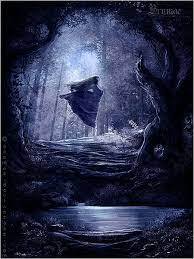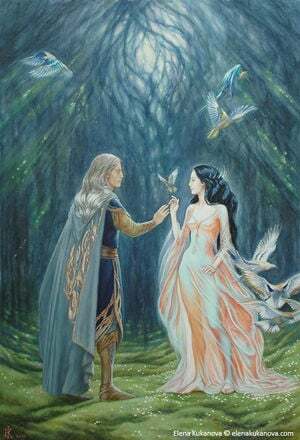Blind Read Through: J.R.R. Tolkien; The Book of Lost Tales, part 2, The Lineage of Tinúviel

“Lo now I will tell you the things that happened in the halls of Tinwelint after the arising of the Sun indeed but long ere the unforgotten Battle of Unnumbered Tears. And Melko had not completed his designs nor had he unveiled his full might and cruelty (pg 10).”
Welcome back to another Blind Read! This week we begin Tolkien’s premier work in earnest and dissect the differences between what is in The Book of Lost Tales and what would eventually come in The Silmarillion.
The opening quote of this essay introduces the story to the reader, setting the stage for the events to come, but then Tolkien takes a step back and talks of the Elves of Doriath (which were not called such in this early version).
“Two children had Tinwelint then, Dairon and Tinúviel, and Tinúviel was a maiden, and the most beautiful of all the maidens of the hidden Elves, and indeed few have been so fair, for her mother was a fay, a daughter of the Gods; but Dairon was then a boy strong and merry, and above all things he delighted to play upon a pipe of reeds or other woodland instruments, and he is named now among the three most magic players of the Elves… (pg 10).”

If you have read The Silmarillion, you will probably recognize Tinúviel, and also Dairon as close to a character who stuck around. Still, otherwise, the names of the rest of the characters are entirely different.
Starting with our Titular character, Tinúviel, we know she kept that name in The Silmarillion. It’s the name Beren gave her because it means Nightingale, and he called her that when he found her dancing and singing in the forest. Her name changed to Lúthien, but there is still enough of a thread that it’s easy to keep everything in order.
Next, we have Tinwelint, who gained many names in the future as Tolkien began to develop his languages. Tinwelint became Elwë Singollo, leader of the hosts of the Teleri Elves, along with his brother Olwë. When Elwë led his people from Cuiviénen to Beleriand (the Teleri were known as the Last-comers, or the Hindmost, because, well, they were the last to come to Beleriand of the Eldar), he settled in the forests of Doriath (Where Beren saw Lúthien dancing). He ruled there under his better-known name, Elu Thingol.
Gwendeling, his wife, was not mentioned in the above quote but was also known as Wendelin in the Book of Lost Tales. She is a fay who falls in love with Tinwelint, marries him, and has two children.

Gwendeling, in my opinion, is how Tolkien decided to make the shift for the Maiar because, through the development of the Lay of Lúthien, he understood that women should play a much more significant role than he had initially been written (probably because of the influence of Edith). Gwendeling needed to possess powers of influence, most notably creating the Girdle of Melian, a protective shield over Doriath.
Because of this more extensive influence, Tolkien changed her lineage, and she became a Maiar, along with all of the other “children of the Valar” or Fay who never had a specific history. Doing so enabled Tolkien to have the Maiar keep their power set while at the same time lessening the ability of the Valar to have children (because if they are immortal, what is to stop them from continuing to have children who could potentially mess with the timeline)?
So Gwendeling became Melian the Maiar but stayed wife to Eru Thingol. That enabled Tolkien to make Lúthien a more robust character because she is the daughter of a demi-god and an immortal, but it left him in a strange quandary. In the book of lost tales, Tinúviel had a brother Dairon, and if he were to remain, he would also have to be a little more potent than the other Eldar because of his mother’s blood.

Dairon in the Book of Lost Tales is very talented, but one of those kids without any drive, as we see from the quote above. What he did possess, however, was an uncanny ability for music. He was considered the third-best “magic player” in the land, behind Tinfang Warble and Ivárë. You might remember Tinfang Warble from The Book of Lost Tales, part 1, because he was the half-fay flutist in the Cottage of Lost Play.
To adjust this inequity of power, Tolkien decided to slightly change Dairon’s name to Daeron, who then became one of the greatest minstrels of all time; in fact, the only being to come close to him was Maglor, Fëanor’s son (who is probably the later iteration of Ivárë). However, he became just a regular Eldar, no longer Thingol and Melian’s son, but rather a trusted loremaster of Thingol. More importantly, he was deeply in love with Lúthien.
This adjustment makes for a slightly better tale because rather than her brother betraying her excursion after Beren, it is an unrequited lover looking out for her best interest when he betrays her trust and tells Thingol that she went after Beren.
That takes care of the family, but what then of Beren? The most provocative change that Tolkien made here is that in the Book of Lost Tales, part two, is that Beren is an elf, not a man.
I believe he did this for several reasons, but two of them stand out to me the most:
Men were not awake yet. At the end of the Book of Lost Tales, part 1, we see that they are children lounging by the Waters of Awakening. Tolkien didn’t spend time developing them like in The Silmarillion. Plus, The Silmarillion is considered the history of the Elves, even though much more happens there, so it makes sense that Beren would be an elf early on.Changing Beren to a Man adjusts the Legendarium in a fun and dynamic way. Now we have the dichotomy of the difference between Elves and Men and what that would mean for them to come together, fall in love, and potentially have children. The remainder of the time in Middle-earth stems from this relationship, so Tolkien needed to adjust it.That was a lot to break down in just the opening pages! Join me next week as we dive into the story proper!



